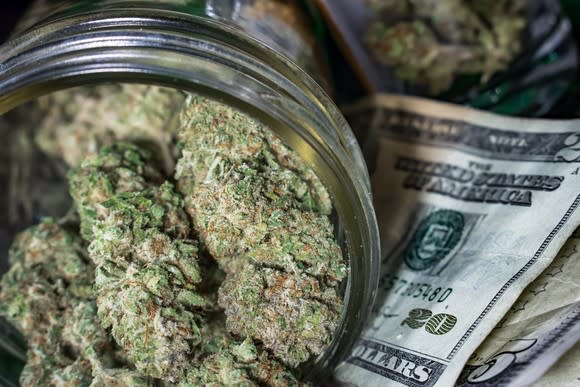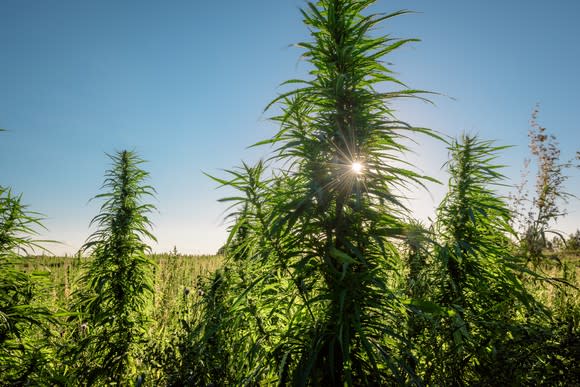Wow! Here's How Much Marijuana Canadians Bought in 2017
There's a really good reason the marijuana industry is called the "green rush" -- growth has been veritably unstoppable. According to ArcView, a leading cannabis research company, legal cannabis sales are expected to grow by 26% a year through 2021. Should this forecast come to fruition, the North American market could be generating almost $22 billion in annual sales.
Consumer opinions on pot have also been improving at a steady pace. Back in 1995, the year before California became the first state to legalize medicinal cannabis, just a quarter of the respondents in Gallup's annual survey favored legalizing weed. By October 2017, this favorability reached an all-time high of 64%.

Image source: Getty Images.
A tale of two North American markets
Nevertheless, there's a big difference among the U.S. and Canadian cannabis markets in North America. The U.S. has grown into a market that genuinely doesn't support the expansion of marijuana. It remains a Schedule I substance at the federal level, meaning it's wholly illegal, is prone to abuse, and has no recognized medical benefits. What's more, Attorney General Jeff Sessions recently rescinded the Cole memo, which was a loose set of rules that legalized states abided by to keep the federal government off their backs. This included keeping cannabis away from adolescents, as well as keeping legal weed within a state.
By comparison, Canada has become the blueprint of success for the marijuana industry. Medicinal cannabis has been legal since 2001, and Health Canada continues to oversee the issuance of licenses for the medical industry. In fact, a handful of Canadian growers have been generating profits solely on account on medical marijuana sales thanks to growing patient demand, and strong patient enrollment.
Furthermore, Canada appears to be on the verge of legalizing recreational pot this coming summer. Conservatives, and those who oppose the expansion of legal weed, are in the minority in Canada's parliament, and the federal government recently proposed a tax-sharing agreement from pot sales that the provinces agreed to. The green-lighting of adult-use sales could generate an additional $5 billion in annual sales once the industry is fully ramped up.

Image source: Getty Images.
Canadians bought a lot of weed last year
But truth be told, we don't have to wait till this summer to see just how much Canadians love their cannabis. According to recently released data from Statistics Canada, an estimated 4.9 million Canadians between the ages of 15 and 64 purchased $4.6 billion (CA$5.7 billion) worth of marijuana in 2017. This works out to about $974 per cannabis consumer. Keep in mind that this includes medical marijuana, as well as recreational cannabis, which has been given the green light in some provinces.
How does this compare to other so-called vice industries, you wonder? Data shows that the alcohol and tobacco industries in Canada generated a respective $18.1 billion and $13 billion in sales in 2016. Though cannabis still has a long way to go to catch these traditional vice industries in sales, the Canadian pot industry does have a major leg up when it comes to domestic production. The vast majority of alcohol and tobacco sold in Canada is imported. Meanwhile, practically all of the cannabis sold to Canadians is grown within the country. In fact, sales of Canadian cannabis outside the country as a percentage of total production has increased from 2% in 1961 to 20% as of 2017. Canadian growers are finding consumers, whether they be domestic or abroad.
Here's another interesting tidbit: according to Statistics Canada, more than 90% of the $4.6 billion sales figure were for non-medical purposes! This demonstrates just how much of a monster the recreational industry could be if the federal government continues to move along measures to legalize adult-use pot.
However, it's also worth pointing out, per the data dump by Statistics Canada, that non-medical weed prices have been in a multi-year decline. It estimates that the price per gram for non-medical purposes has fallen by an average of 1.7% annually since 1990 to around $6.09 (CA$7.50) per gram in 2017. Comparatively, the Canadian Consumer Price Index has increased by an average of 1.9% annually over that same timeframe. This would suggest that volume may be needed by growers to make up for declining prices in the future, should this trend persist.

Image source: Getty Images.
Consolidation should work in Canadian growers' favor
Nonetheless, these trends generally point to positives for Canadian pot stocks. It shows that consumers are demanding cannabis, and that growers have multiple channels to reach these consumers, which includes domestic sales, expanded product lines, and exports to countries that have legalized medical weed.
Unlike the pot industry in the United States, the Canadian weed industry is also highly consolidated, which is a big reason it's so successful. Though marijuana proponents in the U.S. favor the ability of small businesses to get in on the green rush, the consolidation of the Canadian industry is responsible for keeping growing costs down, and it'll likely stem the aforementioned decline in cannabis prices over the past 27 years.
Four growers may wind up controlling around half of Canada's market share when all is said and done, even with Health Canada easing restrictions and shortening the process to allow more licensees to grow cannabis. For example, Canopy Growth Corp. (NASDAQOTH: TWMJF), the largest marijuana stock by market cap, is currently developing or constructing 2.4 million square feet of growing capacity in British Columbia, and has the option of leasing an additional 1.7 million square feet in B.C. It's possible that Canopy could control 15% of the total legal weed market when fully ramped up. It has the deep pockets and production capabilities to temporarily drive margins down, if need be, in order to push smaller businesses out of the picture.
As has been the case for some time now, investors looking to get in on the green rush should overlook what had previously been touted as the world's top marijuana market, the United States, and instead focus on Canada, the current blueprint of success for the pot industry.
More From The Motley Fool
Sean Williams has no position in any of the stocks mentioned. The Motley Fool has no position in any of the stocks mentioned. The Motley Fool has a disclosure policy.
